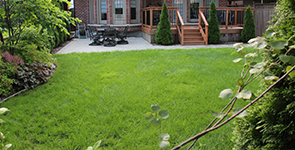
Summer 2016 reports indicate that we have received approximately half the normal rainfall in May and June, and have had 3 times as many 30 C. temperature days, which causes soil to dry out faster. It is likely the heat will continue or increase in the summer months, so we wanted to reach out with some information on caring for your properties in these conditions.
Below is the general watering instructions attached are for normal weather conditions.
In these extreme conditions, we recommend 30 mins per day for lawns and gardens, and water twice daily for containers with drainage. However, it’s important to check your soil regularly and adjust your watering schedule as needed.
Landcare recommends for hot and dry weather watering 30 mins per day for lawns and gardens, and water twice daily for containers with drainage. However, it’s important to check soil and adjust schedule as needed.
Check soil to see if it is dry or wet by probing the top 10 cm (4 inches) of soil with your finger. If it’s dry, then it is time to water. Or insert a stick for count of 10, if base of is cold and damp you don’t need to water.
Drought symptoms begins at edges of plant and works towards center. Leaves will wilt and yellow, or can turn brown or fall off.
Container plants can be watered once a day, but check the soil moisture with fingers to avoid overwatering. Some without drainage will hold moisture longer. You may want to move containers into shade if you are going away.
Lawns are fairly drought resistant compared with other plants, but they can become yellow, limp and eventually bald if the following precautions are not taken: cut the lawn less frequently than usual. Raise the height of lawnmower blades. Use the best watering techniques. Well established lawns do have a dormant period when they are more yellow and can survive with less water.
Mulch is an effective heat barrier, helping keep moisture longer in garden beds.
Hand watering should be done at the soil level as much as possible. Avoid wetting leaves, especially for those in direct sunlight, as they can be scorched as the water heats and evaporates. Early morning watering will help with this issue as well.
Overwatering in these conditions is unlikely to overwater, but be careful with containers without drainage. Overwatering but can be as damaging to plants as a lack of water, and unfortunately an overwatered plant tends to look similar to a plant that is deprived of water, starting with wilting and yellowing at the edges and moving inward. So be aware of the soil moisture by checking regularly.
